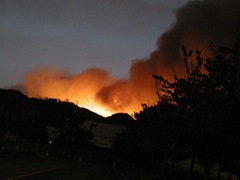The NEW Disaster Media
 The conflagration in San Diego County is both terrifying and surreal. People are talking about the apocalyptic view they have from their kitchen windows; then we hear than more than a quarter million people have been evacuated. My best wishes go out to everyone affected by this amazing tragedy.
The conflagration in San Diego County is both terrifying and surreal. People are talking about the apocalyptic view they have from their kitchen windows; then we hear than more than a quarter million people have been evacuated. My best wishes go out to everyone affected by this amazing tragedy.
Because of the drawn-out nature of this disaster, we are being “treated” (I hesitate to use that word) to a near constant stream of new, terrible information. Traditional media (TV and radio) is doing its best to keep up, but the disaster is simply too wide spread and constantly changing to offer real-time updates. And, to be frank, it’s too dangerous – I’ve already read one report of a reporter heading out to a scene only to be rebuffed for fears of the crews’ safety.
In it’s place, social media has stepped up to the plate and offered a first-person account of one of California’s largest disasters. Bloggers, vloggers, texters, and mappers are constantly updating the stream of information coming out of San Diego County as it is being made available. Evacuation orders are being put online before the local news gets their hands on them. People are building interactive maps so as to get a finger on the developing situation. While I’m not yet privy to any video of the fires, I’m positive that some local vlogger has posted something somewhere.
This is the reality of disaster reporting today. Increasingly better information, more up-to-the-minute reporting, more relevant stories will be posted on social media websites hours before the traditional media gets it out. Some traditional media members are already dependent on the blogs to get the latest, and it will only continue. Gerald Baron, the Crisisblogger, has had a few posts lately that demonstrate this perfectly: here, on social media’s impact on crisis communication; and here, on cell phone cameras during a disaster.
What does this changing world of disaster PR mean for you and me? Think of your particular disaster. You’re pumping out press releases to the media, are fielding calls, and the governor’s coming to give a speech. Everything’s under control, right? Now, imagine 200 people in the disaster scene or with a view of the disaster all giving their opinions, giving a first-hand account of the devastation, and taking pictures or video. Then, give those 200 people the largest bullhorn in the world. Put them in the den or office of every person across the country. You will NEVER have PR in a disaster controlled again. Instead of being the voice of authority, you are now but one of many voices – and one of the only ones that doesn’t have grisly footage.
I, for one, think it’s a great opportunity, both for bloggers and crisis communicators – if we can take advantage of it. Ignoring this reality only does a disservice to those who depend on us.
The following links will take you to social media sites that are tracking the developing disaster. I’m sure that a quick search on Technorati or Google Blog Search will turn up tons more.
DailyKos California Wildfire Liveblog
CC-licensed Flickr images of “san diego fire”
Best of luck to San Diegoans today.
Photo credit: Bubba Hotep
UPDATE: From the comments – Nate Ritter passed along his Twitter-feed, wherein he’s helping keep San Diegoans up-to-date on the latest news and evacuation updates. This is a perfect example of something we talked about before, using Twitter for on the run updates in a disaster situation. One of his latest Tweets notes that he and his wife are about to leave. Nate, I wish you good luck and hope your leaving ends up being not necessary.
UPDATE 2: List of updated Google maps from the Google blog here.




You can follow my twitter feed as well, which has consistently been updated all day: Twittering the San Diego fires.
Thanks Nate. You’re a perfect example of what I’m talking about. Keep up the good work, and please be safe. I’m updating my post so your Twitter-feed gets more exposure.
-Jimmy
Hey Jimmy – if you’re interested in tracking random mentions, Twitter now has a “track” feature.
From your phone or IM, send “track wildfire”, and you’ll get every public Tweet that has that word.
“untrack wildfire” will turn it off.
Try it with a variety of keywords.
(We’re doing some updating on our redcross Twitter channel, but haven’t promoted it enough out west to force it. I will update it as I get information from the response there…)
Ike:
Thanks for the news. That’s a very helpful update to Twitter, and only increases its usefulness in this situation.
-Jimmy